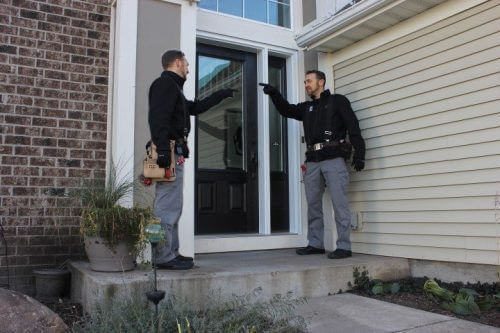
When it comes to buying a home, so many factors go into the equation. It’s an overwhelming process, from negotiating with your seller to deciding what type of mortgage you want. Getting a home inspection before signing papers and taking ownership may not be top of mind. It’s easy to overlook this step because you’re eager to settle into your new space! However, a professional inspection can help you avoid costly repairs or hidden issues in the future by identifying any potential problems in the property now. Plus, they offer peace of mind for both buyers and sellers alike! To ensure a smooth transition from house hunting to homeownership, we’ve compiled ten questions every buyer should ask their inspector during their walkthrough:
1. What is the age of this home?
Find out how old your Sheffield Iowa homes for sale are, or find a newer home inspector who has a better idea of what is going on in the construction industry. If you are looking to build, it may be time to get the ball rolling. The age of the house will be helpful to know because it can help you find out the standard of maintenance and any changes made. For example, if you have a homeowner who has lived in their home for ten years or longer, they may not continue having regular upkeep, which will show up as problems further into your ownership. If the house was re-sided with aluminium or vinyl, this could be a lot more affordable, and you may see some issues with the quality of installation.

2. Are there any signs of water damage or mould on the walls, ceilings, or floors?
Is there a gas leak anywhere in the house? Water damage can cause several issues such as mould and structural instability or rot. When inspecting this, look for bubbles in the paint, warped floors and ceilings (wavy or buckling), peeling wallpaper, etc. Check areas around windows, doors and ventilation points into the house, too, since water leaks near these entryways is a common sign of a potential issue. A gas leak can be a significant hazard in your home, so this is something you want to pay attention to and make sure the inspector doesn’t miss! Finally, look for any signs of damage around the furnace or water heater, especially near ventilation points into the house (e.g. cracks in the furnace room wall), and see if the inspector checks those because the same can affect your thermostat’s settings.
3. Does your furnace have an air filter that needs to be replaced every month/year/whenever it’s dirty?

If so, ask the inspector and make sure they look at it during their inspection. If not, remember to change your filter once a month or before the seasons change (in some parts of the country), whichever comes first! Failing to replace air filters can cause severe strain on your furnace. Look for any signs of damage around the stove or water heater, especially near ventilation points into the house (e.g. cracks in the furnace room wall), and see if your furnace has been exposed to any water damage. These appliances are expensive to repair and protect, so the inspector mustn’t miss anything that could make its repair cost more than necessary down the road!
4. How old is the roof, and how many layers of shingles are there?

Be sure to ask your inspector if the roof is nearing or past its useful life. Replacing roofs can cost anywhere from $5,000 to even $50,000. If you feel like you might need a roof replacement soon, consider rescheduling your inspection or ask if the inspector can provide an opinion on how much longer it will last.
5. What kind of insulation does the home have?
Different forms of insulation have different R-values or levels of thermal resistance (the ability to resist heat flow). For example, fiberglass batts are available in standard and higher mass R-value per inch insulation.
- Is there enough insulation in the attic? Be sure to ask this question and look for loose insulation or open vents in the attic. Insulation is key to reducing your energy costs! According to the U.S Department of Energy, adding insulation can save you anywhere from $120 to $700 annually.
6. Does the home have a crawl space?
A crawl space is often an area under the house that can sometimes be covered by plywood or concrete. This area is a prime spot for insulation but can be expensive to insulate properly. Surprisingly, basements often have less insulation than crawl spaces because it is more difficult to access this area. Be sure that your inspector points out the insulation in these areas and advises you on how best to improve its effectiveness for future changes.
7. Are all windows, doors, and screens intact with no cracks or broken glass?

If a window has been added since construction, it could harm insulation even if they built the structure with energy efficiency features. If possible, make sure your windows are intact before you close and obtain the manufacturer’s information from your realtor. It will allow you to replace broken windows with energy-efficient units, which will help keep heating and cooling costs as low as possible for years to come.
- If yes, are they all functional? Doors and screens not only let fresh air in but also keep bugs out. If a door or window isn’t closing correctly due to warped wood, warping from water damage, or another issue you spot during your walkthrough, you’ll have to fix it before moving in and consider whether it’s cost-effective.
- Are exterior doors and windows intact? Broken locks, warped door frames, and broken window panes may give thieves opportunities to break in. Doors should latch securely when closed because ring doorbell doesn’t ring automatically when someone is trying to break-in; windows should lock if they have a locking mechanism.
8. What are the measurements of the electrical panel?
To ensure that it can accommodate all your power needs you need an apt electrical panel. You need to ensure that you will have enough power outlets in your home without expanding the electrical panel. If you already know that you need to broaden your discussion, notify your inspector to provide insight into what needs to be done for the work to pass inspection.
9. Does this home have any termites, fungus, mould or other pests?
Check for signs of rodent infestation, such as droppings and nesting materials. Check where pipes enter the house, too, since this is another common entry point for rodents from underground burrows or attics (usually roof-accessible). A big part of inspecting your home before buying it is ensuring its safety, especially against hazards that could lead to injury. Check to see that the inspector pays attention to and makes sure the inspector doesn’t miss!
Conclusion: make sure you inspect with a keen eye and ask the right questions. After all you are going to live in the house for a long period.
Alexander Martin
Related posts
Stay connected
Today's pick
- Things to Remember While Designing Your Custom Modular Kitchen in GurgaonGurgaon now known as Gurugram is the second largest city in the state of Haryana and is a reflectiossn of an ideal modern city with futuristic goals. Witnessing rapid urbanization, it has also emerged as a hub for contemporary homes, with homeowners seeking innovative and... The post Things to Remember While Designing Your Custom Modular […]
